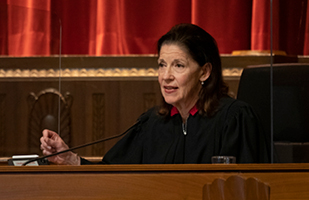Judge Comes Full Circle with Supreme Court

Prior to her most recent case, Eleventh District Judge Mary Jane Trapp last sat for the Supreme Court in November 2019.

Prior to her most recent case, Eleventh District Judge Mary Jane Trapp last sat for the Supreme Court in November 2019.
Whenever Eleventh District Court of Appeals Judge Mary Jane Trapp hears an oral argument for the Supreme Court of Ohio, she’s reminded of the first time she worked at the Court.
“I was a summer intern in the law library when I was in college,” said Judge Trapp, a member of the Eleventh District for nearly 10 years.
In her return to the Supreme Court, Judge Trapp heard the case of State v. Gwynne in place of Justice Michael Donnelly, who recused. According to the Ohio Constitution, in the event of a justice’s recusal, the chief justice selects an appellate court judge to sit temporarily on the Supreme Court.
Judge Trapp’s research for the Gwynne case, which argues the constitutionality of a woman’s 65-year prison sentence for stealing from nursing homes and assisted-living residences, is the latest evolution in her decades of working with the Court. Throughout her years as a judge and attorney, she has served on nine Supreme Court commissions, committees, and task forces to develop better policies for the practice of law in the state.
“Judges have the obligation to be seen, not just on the bench,” said Judge Trapp. “We have an obligation to our profession to make our work and ourselves better.”
Helping others to untangle intricate issues stems from her grandfather, who was a high school teacher and football coach. He sparked her interest in history, political science, and constitutional law. The result was a deep interest in complex cases both as a judge and in private practice.
“I enjoyed handling my firm’s most difficult cases,” Judge Trapp said. “It was my job to go through this big box of documents and figure out what happened.”
She would then have to take all that material and explain her findings to a wide range of people. Like a coach with a game plan, that information needed to be clear to people with various levels of understanding – colleagues, clients, judges, or litigants. The communication and collaboration has served Judge Trapp in her appellate work, as Ohio State Bar Association (OSBA) president, and as a mediator.
The judge’s efforts have been recognized statewide as the recipient of the highest honors from the OSBA and the Ohio Access to Justice Foundation. As a private mediator, she had a 95% settlement rate, utilizing dispute resolution methods to bring people on opposite sides closer together.
“I would always bring my ‘magic mediation’ bread,” Judge Trapp said referring to her lemon pistachio loaf. “It was just a way for two people with differing viewpoints to share something, to help calm the situation.”
As an appellate jurist, she can have discussions with other judges or justices to better understand the key claims and how they stack up against the law. She then relies on the research skills she began developing decades earlier for the Supreme Court and taps into the intellectual curiosity from her grandfather.
“Looking at the facts and the law leads me to a result,” Judge Trapp said. “When I write my decision, I believe in my heart and my mind that is the right outcome because I followed that path.”


